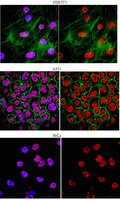MAB11004 Sigma-AldrichAnti-hnRNP Q Antibody, clone 7A11.2
Anti-hnRNP Q Antibody, clone 7A11.2 is a Mouse Monoclonal Antibody for detection of hnRNP Q also known as heterogeneous nuclear ribonucleoprotein Q-like & has been validated in WB, ICC.
More>> Anti-hnRNP Q Antibody, clone 7A11.2 is a Mouse Monoclonal Antibody for detection of hnRNP Q also known as heterogeneous nuclear ribonucleoprotein Q-like & has been validated in WB, ICC. Less<<お勧めの製品
概要
| Replacement Information |
|---|
主要スペック表
| Species Reactivity | Key Applications | Host | Format | Antibody Type |
|---|---|---|---|---|
| H, M, R | WB, ICC | M | Purified | Monoclonal Antibody |
| References |
|---|
| Product Information | |
|---|---|
| Format | Purified |
| Control |
|
| Presentation | Purified mouse monoclonal IgG1κ in buffer containing 0.1 M Tris-Glycine (pH 7.4), 150 mM NaCl with 0.05% sodium azide. |
| Quality Level | MQ100 |
| Physicochemical Information |
|---|
| Dimensions |
|---|
| Materials Information |
|---|
| Toxicological Information |
|---|
| Safety Information according to GHS |
|---|
| Safety Information |
|---|
| Storage and Shipping Information | |
|---|---|
| Storage Conditions | Stable for 1 year at 2-8°C from date of receipt. |
| Packaging Information | |
|---|---|
| Material Size | 100 µg |
| Transport Information |
|---|
| Supplemental Information |
|---|
| Specifications |
|---|
| Global Trade Item Number | |
|---|---|
| カタログ番号 | GTIN |
| MAB11004 | 04053252750229 |
Documentation
Anti-hnRNP Q Antibody, clone 7A11.2 (M)SDS
| タイトル |
|---|
Anti-hnRNP Q Antibody, clone 7A11.2 試験成績書(CoA)
| タイトル | ロット番号 |
|---|---|
| Anti-hnRNP Q, clone 7A11.2 - 2453291 | 2453291 |
| Anti-hnRNP Q, clone 7A11.2 - 3146935 | 3146935 |
| Anti-hnRNP Q, clone 7A11.2 - 3269455 | 3269455 |
| Anti-hnRNP Q, clone 7A11.2 - 3385833 | 3385833 |
| Anti-hnRNP Q, clone 7A11.2 - 3423235 | 3423235 |
| Anti-hnRNP Q, clone 7A11.2 - 3746894 | 3746894 |
| Anti-hnRNP Q, clone 7A11.2 - 3860929 | 3860929 |
| Anti-hnRNP Q, clone 7A11.2 - 3975861 | 3975861 |
| Anti-hnRNP Q, clone 7A11.2 - NRG1856990 | NRG1856990 |
| Anti-hnRNP Q, clone 7A11.2 -2586539 | 2586539 |















